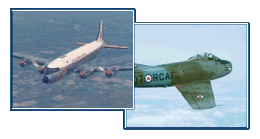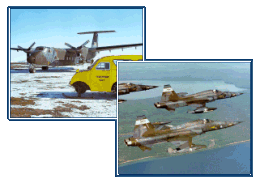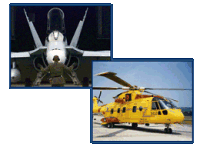 |
Royal Canadian Air Force |
 |
|
1924 - 1938
The reorganization of the Canadian Air Force was completed, and the prefix "Royal" officially adopted, on 1 April 1924. That date, on which Canada's fifth air force organization came into being as a permanent component of her defence forces, marked the birthday of the Royal Canadian Air Force.
Since it inception in 1924 the RCAF had been heavily involved in civil air operations. Forestry patrols, anti-smuggling, forest spraying, and surveying. In 1936 it was decided that the RCAF should be a purely military organization and the Department of Transport was formed to establish and implement a civil aviation policy. Thereafter the RCAF's only involvement in civil aviation was aerial photography, a task that would increase in importance as time passed.
Freed of its civil responsibilities, the RCAF was reorganized along service lines and developed into a military air force. Four new squadrons were formed although these still operated in the largely civil duties of transport, and photo survey. With the creation of the Department of Transport the RCAF was authorized to form 3 purely military squadrons.
- No. 2 Army Cooperation
- No. 6 Torpedo Bomber
- No. 3 Bomber
All three units had were based at RCAF Station Trenton, Ontario which had opened in 1931 as the RCAF's main training base. In May of 1937 No. 3 Bomber squadron was reorganized as a pure bomber squadron and the fighter flight of No. 3 squadron was removed to form the nucleus of No. 1 Fighter Squadron - the eighth and last permanent force squadron to be formed before the second world war.
|
| |
|
 |
Royal Canadian Air Force |
 |
|
1939 - 1946
In December 1938 the RCAF, which had been under the Chief of Staff and later the army, became and independent arm directly under the Minister of National Defence.
The RCAF peace establishment called for a total of twenty-three squadrons, of which eight of the eleven permanent squadrons had been formed on the eve of war. In the first month of World War II it was found that only fifteen squadrons could be brought up to strength and mobilized - twelve for home defence and three for overseas service. For aircraft there were 20 different types totaling 230 aircraft, over half were training or transport aircraft, and only nineteen (19) Hurricanes and and ten (10) Fairey Battle light bombers could be considered front line aircraft.
From this small nucleus both in personal and equipment the RCAF expanded to become the fourth largest allied air force.
The wartime RCAF consisted of three main parts, two of which were in Canada. The British Commonwealth Air Training Plan the other the Home War Establishment - which was to deploy thirty-seven squadrons for coastal defence, protection of shipping, air defence and other duties in the western hemisphere. The third with its headquarters in London, England the Overseas War Establishment. At the end of the war it had forty-eight squadrons serving with the Royal Air Force in Western Europe, the Mediterranean and the Far East.
On the first of January 1944 the RCAF reached its peak wartime strength of 215,200 all ranks (including 15,153) women, 104,000 were in the British Commonwealth Air Training Plan, 64,928 were serving at home and 46,272 were serving overseas. There were 78 squadrons in service: 35 overseas, 43 at home (of which six had been ordered overseas).
|
| |
|
 |
Royal Canadian Air Force |
 |
|
1947 - 1968
On the first of January 1944 the RCAF reached its peak wartime strength of 215,200 all ranks (including 15,153) women, 104,000 were in the British Commonwealth Air Training Plan, 64,928 were serving at home and 46,272 were serving overseas. There were 78 squadrons in service: 35 overseas, 43 at home (of which six had been ordered overseas). By April 1, 1945 the strength of the RCAF had been reduced to 164,846 all ranks through the termination of the BCATP and a reduction of the home war establishment. With the formal end to hostilities on September 2, 1945, and a proposed peace time establishment of 16,000 all ranks, a two year "interim period" was declared during which the emphasis was to be on demobilization of approximately 90% of the wartime force.
 Beginning in 1948, the RCAF began to reorganize its command structure along functional rather than regional lines. No 9 (Transport) Group was elevated to Air Transport Command and No 1. Air Defence Group was formed. In 1949 , Maintenance Command became Air Materiel Command; Central Air Command was renamed Training Command; and Nos. 10 and 11 Groups were redesignated Maritime and Tactical Group respectively. Increased tension in world affairs in the early 1950's resulted in further expansion, with the formation of No. 1 Air Division Europe, No. 5 Air Division (formerly No. 12 Group) and No. 14 (Training) Group, while a number of groups were elevated to command status: Air Defence Command, Maritime Air Command, Tactical Air Command. Beginning in 1948, the RCAF began to reorganize its command structure along functional rather than regional lines. No 9 (Transport) Group was elevated to Air Transport Command and No 1. Air Defence Group was formed. In 1949 , Maintenance Command became Air Materiel Command; Central Air Command was renamed Training Command; and Nos. 10 and 11 Groups were redesignated Maritime and Tactical Group respectively. Increased tension in world affairs in the early 1950's resulted in further expansion, with the formation of No. 1 Air Division Europe, No. 5 Air Division (formerly No. 12 Group) and No. 14 (Training) Group, while a number of groups were elevated to command status: Air Defence Command, Maritime Air Command, Tactical Air Command.
From a regular force of 11,569 officers and airmen and a Auxiliary of 655 on December 31, 1947, the RCAF was to show a steady growth a relations between the western democracies and the Communist bloc deteriorate. In January 1944 the strength"ceiling" was lifted to 51,000, placing the RCAF, for the first time in history, higher than the army. From five regular force squadrons in 1947 the RCAF reached a peak of 29 Regular and 12 Auxiliary flying squadrons in 1955. Commencing in 1962, it was gradually reduced as the CF-100's were withdrawn from operational service and replaced by fewer CF-101 Voodoos, and as the CF-104 Starfighter replaced the aging Sabres from the Air Division in Europe.
|
| |
|
 |
Canadian Armed Forces - Air Command |
 |
|
1969 - 1982
In February 1968 the RCAF consisting of 18 operational squadrons, four training and six auxiliary squadrons was integrated into the Canadian Armed Forces and ceased to exist as a separate and independent force
The RCAF was integrated into the Canadian Armed Forces and became part of the following:
 Maritime Command Maritime Command - - embodying all sea and air maritime forces on both the Atlantic and Pacific seaboards, was primarily responsible for antisubmarine defence, but was to become increasingly capable of other tasks such as patrolling the arctic region.
- Air Transport Command
- - would provide the forces with "strategic airlift capability", the emphasis being on troop carrying operations.
- Air Defence Command
- - was to contribute squadrons of CF-101 Voodoo interceptors, and surveillance and control radar, to North American Air Defence Commands
- Mobile Command
- - was the combination of all ground forces as well as air elements, consisting of CF-5 Tactical Fighters, CC-115 Buffalo Transport Aircraft, and rotary wing elements.
- Training Command
- - was responsible for all individual training including flying and trades training.
- Material Command
- - would provide the necessary supply and maintenance support to the other functional commands.
In addition there were: Reserve and National Survival; Communications System (elevated to command status in 1970); and Canadian Forces Europe (consisting of the 4th Canadian Mechanized Brigade Group (4 CMBG) and No. 1 Canadian Air Group. (1 CAG)
|
| |
|
 |
Canadian Armed Forces - 1 Canadian Air Division / Canadian NORAD Region |
 |
|
1983 - present
 After approximately 15 years of unification the Canadian forces were more or less returned to three separate forces, while retaining an integrated command and supply structure. The Navy had back their Naval uniform and insignia, the Air Force was in control of all air assets and got back their blue uniforms but sadly not the air force rank system. These changes occurred slowly over time and the "Air Force" evolved. After approximately 15 years of unification the Canadian forces were more or less returned to three separate forces, while retaining an integrated command and supply structure. The Navy had back their Naval uniform and insignia, the Air Force was in control of all air assets and got back their blue uniforms but sadly not the air force rank system. These changes occurred slowly over time and the "Air Force" evolved.
- Air Command (14 Training Group, 10 Tactical Air Group, Maritime Air Group, Air Defence Group/Fighter Group, Transport Group)
On July 31, 1997 all previous commands and groups were disbanded and replaced by 1 Canadian Air Division / Canadian NORAD Region (1 CAD/CANR) with a operations structure based on the traditional wing concept. The 1 CAD wings are as follows:
- 1 Wing - Kingston
- 3 Wing - Bagotville
- 4 Wing - Cold Lake
- 5 Wing - Goose Bay
- 8 Wing - Trenton
- 9 Wing - Gander
- 12 Wing - Shearwater
- 14 Wing - Greenwood
- 15 Wing - Moose Jaw
- 16 Wing - Borden
- 17 Wing - Winnipeg
- 19 Wing - Comox
- 22 Wing - North Bay
In 1999 the Canadian Air Force celebrated its Diamond Jubilee after 75 years serving Canadians. With its current unified command structure, new programs, and new aircraft Canadians can be proud of their air force and look to the future with much optimism.

|
|





 Beginning in 1948, the RCAF began to reorganize its command structure along functional rather than regional lines. No 9 (Transport) Group was elevated to Air Transport Command and No 1. Air Defence Group was formed. In 1949 , Maintenance Command became Air Materiel Command; Central Air Command was renamed Training Command; and Nos. 10 and 11 Groups were redesignated Maritime and Tactical Group respectively. Increased tension in world affairs in the early 1950's resulted in further expansion, with the formation of No. 1 Air Division Europe, No. 5 Air Division (formerly No. 12 Group) and No. 14 (Training) Group, while a number of groups were elevated to command status: Air Defence Command, Maritime Air Command, Tactical Air Command.
Beginning in 1948, the RCAF began to reorganize its command structure along functional rather than regional lines. No 9 (Transport) Group was elevated to Air Transport Command and No 1. Air Defence Group was formed. In 1949 , Maintenance Command became Air Materiel Command; Central Air Command was renamed Training Command; and Nos. 10 and 11 Groups were redesignated Maritime and Tactical Group respectively. Increased tension in world affairs in the early 1950's resulted in further expansion, with the formation of No. 1 Air Division Europe, No. 5 Air Division (formerly No. 12 Group) and No. 14 (Training) Group, while a number of groups were elevated to command status: Air Defence Command, Maritime Air Command, Tactical Air Command.
 Maritime Command
Maritime Command 
 After approximately 15 years of unification the Canadian forces were more or less returned to three separate forces, while retaining an integrated command and supply structure. The Navy had back their Naval uniform and insignia, the Air Force was in control of all air assets and got back their blue uniforms but sadly not the air force rank system. These changes occurred slowly over time and the "Air Force" evolved.
After approximately 15 years of unification the Canadian forces were more or less returned to three separate forces, while retaining an integrated command and supply structure. The Navy had back their Naval uniform and insignia, the Air Force was in control of all air assets and got back their blue uniforms but sadly not the air force rank system. These changes occurred slowly over time and the "Air Force" evolved.